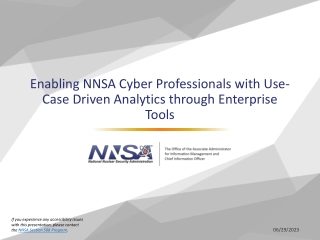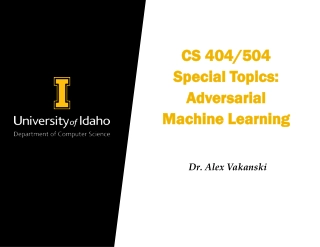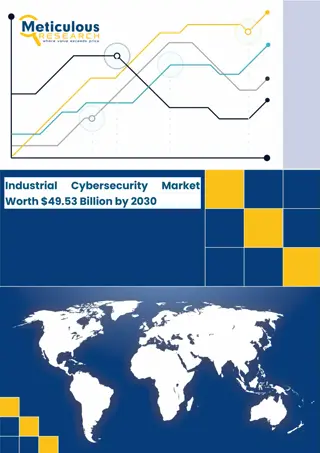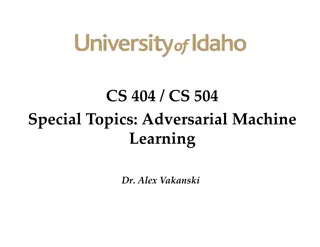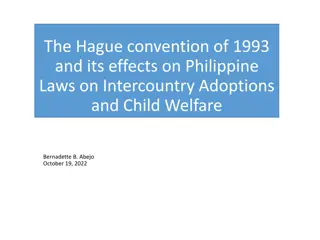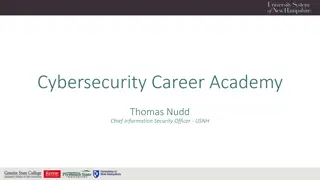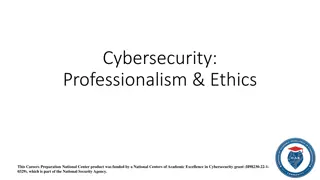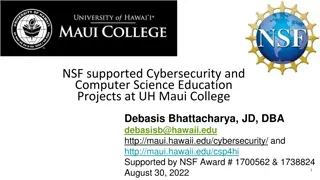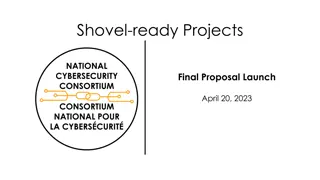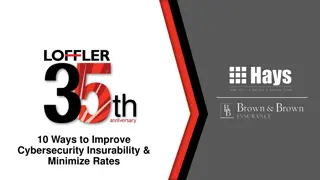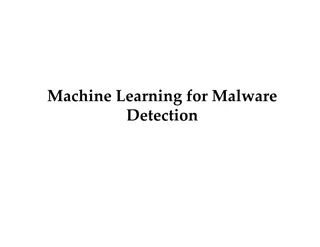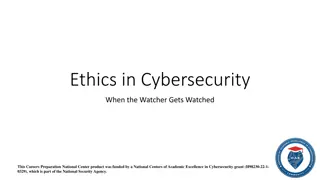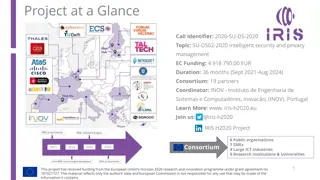Challenges in Cybersecurity Implementation: A Philippine Perspective
A presentation discussing the challenges in cybersecurity implementation specifically in the context of the Philippines. It covers the PPT framework (People, Process, Technology), classes of security measures based on the Philippines Data Privacy Act, roles and responsibilities, best practices for ICT pillars, cybersecurity practices, and awareness among end users and IT workers.
Download Presentation

Please find below an Image/Link to download the presentation.
The content on the website is provided AS IS for your information and personal use only. It may not be sold, licensed, or shared on other websites without obtaining consent from the author.If you encounter any issues during the download, it is possible that the publisher has removed the file from their server.
You are allowed to download the files provided on this website for personal or commercial use, subject to the condition that they are used lawfully. All files are the property of their respective owners.
The content on the website is provided AS IS for your information and personal use only. It may not be sold, licensed, or shared on other websites without obtaining consent from the author.
E N D
Presentation Transcript
Challenges in Cybersecurity Implementation: A Philippine Perspective A presentation to the AP* Retreat @ APNIC 56 Angel S. Averia, jr. President, Philippine Computer Emergency Response Team
CHALLENGES IN CYBER SECURITY IMPLEMENTATION A look into the PPT Framework People Process Technology Sources: https://www.freepik.com/free-vector/portrait-young-employee-team_9650698.htm#query=people&position=6&from_view=keyword&track=sph https://creazilla.com/nodes/7793046-engranatges-clipart https://stock.adobe.com/id/images/id/81017431?clickref=1011lwWIsrbF&mv=affiliate&mv2=pz&as_camptype=&as_channel=affiliate&as_source=partnerize&as_campaign=pdvectors
CHALLENGES IN CYBER SECURITY IMPLEMENTATION Classes of Security Measures by Law: Philippines Data Privacy Act Physical Organizational Technical Sources: https://www.freepik.com/free-vector/security-system-isometric_6089386.htm https://www.alburolaw.com/organizational-security-measures-for-the-protection-of-personal-dat/ https://www.freepik.com/free-vector/safe-data-isometric_6371525.htm
Classes of Security Measures (Data Privacy Act) Organizational Physical Technical Roles and responsibilities are assigned. Everyone is aware, trained, knows, and understand their roles and responsibilities. Everyone has the relevant skills. Those responsible for physical security measures are trained and equipped to use/operate the physical security measures. Those responsible for technical security measures are trained and equipped to use/operate the technical security measures. People ICT Pillars (Best Practice) Policies, rules, procedures, and guidelines on organizational readiness and practice are in place. Cybersecurity & privacy framework adopted. Capacity building programs in place Process Policies, rules, procedures, and guidelines on physical protection measures are in place. Policies, rules, procedures, and guidelines on technical protection measures are in place. Access control Time lock, alarm, CCTV Data vault, Fire proof storage. UPS, genset, fire suppression, and environmental controls Redundancy, Hot/cold backup Data anonymization, segmentation, encryption Access control and VPN Virus control Firewall, IDS/IPS, Network Monitor SIEM or UTM or Threat Intel Technology Online learning courses on cybersecurity and data privacy
CHALLENGES IN CYBER SECURITY IMPLEMENTATION Source: https://www.diamondit.pro/7-layers-of-cybersecurity/
CHALLENGES IN CYBER SECURITY IMPLEMENTATION End Users, including 3rd Party users: cybersecurity awareness and hygiene Information Technology Workers: Network and Data Base Administrators; Developers including analysts, designers, and programmers; and others Web and Application Development Practices: Are Security by Design and Privacy by Design Embedded? People Cybersecurity Work Force: Knowledge and Skills; Certification; Technology specific skills Senior Management
CHALLENGES IN CYBER SECURITY IMPLEMENTATION Cybersecurity governance framework policies, standards, and processes Roles and responsibilities risk assessment and management awareness and capacity development Process 3rd party assurance
CHALLENGES IN CYBER SECURITY IMPLEMENTATION Defining and implementing the appropriate technology Technology
CHALLENGES IN CYBER SECURITY IMPLEMENTATION Survey says . The 2021 Survey was jointly conducted by the DICT and Secure Connections. Secure Connections is a coalition of cybersecurity policy researchers and cybersecurity professionals advocating for a safe and secure Philippine cyberspace environment.
How does the PH govt fare? PH Govt Infosec Survey 2021 Government agencies have good awareness of cybersecurity posture, believe agency has good ability to recover from information security incident, BUT Low awareness of national policies, international standards Low organizational capacity, lack of necessary cybersecurity skills and expertise People More than half of agencies do not have a Computer Emergency Response Team (CERT) Major gaps: policy awareness, organizational capacity, cybersecurity skills, financial resources, leadership support
Cybersecurity Posture Personnel 65% have in-house infosecurity team/personnel - 33% have dedicated team/personnel - 24% have a single personhandling information security 3 out of 10 said their infosec unit significantly understaffed 41% think they are somewhat understaffed People -
Cybersecurity Posture Computer Emergency Response Team (CERT) 6 out of 10 don t have a CERT - lack IT personnel; outdated procurement regulations 2/3 of agencies with CERT are part of a Sectoral CERT. 35% of agency CERTs had responded to an information security incident, in past 12 months; almost half did not People 2 in 10 of agencies did not know if their CERT ever responded to an informations security incident
What are the current policies? Office of the President MO No. 37 s. 2001 DoE Department Order No. 2004-02-002 RA 10175 Cybercrime Prevention Act of 2012 Sec 2(j) National Cyber Security Plan 2004; 2022 (released 2017) DICT MC No. 005 (Aug 2017) RA 11479 The Anti-Terrorism Act of 2020 Sec 3(a) RA 11659 Public Service Act Amendment of 2022 Sec 2(e) Some government agencies have their own information security policies, standards for their respective sectors. Process Not clear how agencies are implementing security measures or adopting any standards, if at all.
What are the gaps? PH lacks a national policy directive mandating government agencies with jurisdiction over critical infrastructure (CI) to promote information security No clarity in institutional arrangements on cybersecurity enforcement, monitoring, and assessment; response to and reporting of cyber incidents; and mitigation of cyber risks Process Poor awareness and adoption of minimum information security standards that will protect CII institutions across the board
Implementation challenges (3Ps) Top factors affecting compliance to NCSP and DICT's policies Process 1. People: availability of technically skilled personnel (62%) 2. Policy: government policy awareness (59%) 3. Pera (Funds): budget/financial resources (56%)
Implementation challenges (3Ps) Top factors influencing implementation of Infosec Standards Process 1. Prioritization: management support/prioritization (57%) 2. People: technically skilled personnel (56%) 3. Pera: budget/ financial resources (56%)
CHALLENGES IN CYBER SECURITY IMPLEMENTATION The Emerging Danger Artificial Intelligence Impact on Cybersecurity People-Process-Technology
CHALLENGES IN CYBER SECURITY IMPLEMENTATION Thank you very much! Maraming salamat!


